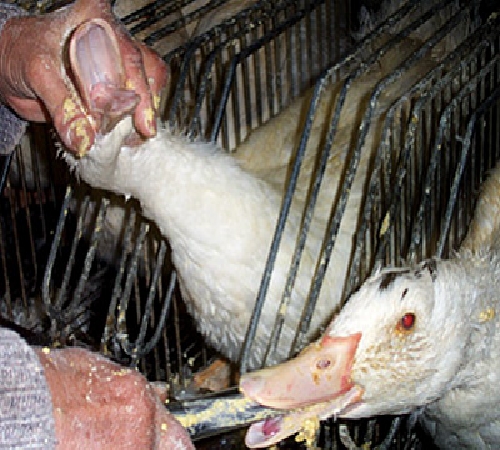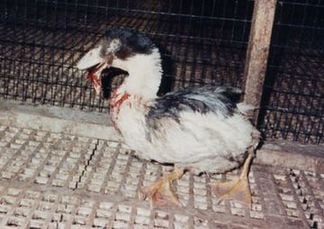Foie Gras is it a delicacy or cruelty?

First I want to say that I am not a vegetarian. I enjoy eating meat and I think that we are omnivorous by nature. I don't have a problem with consuming animals as long as I believe that they were humanely treated in life. Now I know there's not always a guarantee with that but I still won't stop eating meat. I know one delicacy I won't ever be trying is Foie Gras. Foie Gras translated from French is "fat liver". It is made by fattening a Goose or a Duck through a inhumane practice called gavage. Gavage is a French term which means from "to gorge". The technique involves a metal or rubber tube being forced down the unfortunate fowls throat for a period of 1-2 minutes 2–4 times a day, for five weeks. This tube forces a mix of mashed up corn, fats and oils. After receiving these feedings it has been shown that the feeding tubes can scratch up the esophagus, expand the stomach, and swell up the liver to many times it's original size causing all types of disease and infection in the birds.

Why eat Foie gras?
Foie gras is a popular luxury food in French cuisine. Its flavor is characterized as rich, buttery, and delicate, as opposed to a regular duck or goose liver. Foie gras is sold whole, or it could be prepared into mousse, parfait, or pâté (the lowest quality), and may also be served as a side to another food item, including steak and salmon. According to French law, "Foie gras belongs to the protected cultural and gastronomical heritage of France." Today, France is by far the largest producer and consumer of foie gras, though it is produced and eaten globally, particularly by upper class people in other European nations, the United States, and the People's Republic of China. Many Foie gras producers claim that the procedure is not uncomfortable for geese of ducks because they have no gag reflex, and it's just taking advantage of their natural physiology. Judging from the pictures and the videos I've seen I don't think that's so true.

Campaign against Foie Gras
Many animal rights groups including PETA(People for the Ethical Treatment of Animals), Farm Sanctuary, the Humane Society of the United States, and the Animal Legal Defense Fund speak out against the production and distribution of Foie Gras based on the harsh methods used to fatten the birds. PETA claims that the ducks and geese can be wounded, suffer from broken bills, and massive internal infections can develop as a result. In 2003 an organization in France surfaced called StopGavage("Citizens' Initiative for the banning of force-feeding"). The organization published an article, "Proclamation for the Abolition of Force Feeding" which was a request to justices to rule Foie Gras cruel and a violation of animal rights. Stopgavage president Antoine Comiti also criticized the INRA (a French public research institute) of performing a false investigation, and getting paid off from the Foie Gras industry. A few celebrities have joined the cause as well, most notably former 007 star Sir Roger Moore, who released a video for PETA exposing the practices involved in Foie Gras production.
Possible health consequences
Some research studies conducted by Dr. Michael Greger at The The Humane Society of the United States claims that there could be adverse health effects associated with regular consumption of Foie Gras including these various human diseases, among them Alzheimer's, Parkinson's, and rheumatoid arthritis. These human diseases are the formation of amyloid fibrils. Secretions of amyloid fibrils are produced by poultry birds when they are under great amounts of stress. Spontaneous amyloidosis due to a constant inflammatory response that causes amyloid fibrils to form unnecessary, and useless, deposits of this protein-like material in the birds organs. Dr. Greger's research shows that this amyloid fibrils can enter mice being fed amyloid-affected beef succumbing to amyloidosis within only a few weeks. Greger also noted that amyloidosis can occur in a variety of wild and domesticated animals such as, chickens, cattle, dogs, goats, horses, sheep and, rarely, cats and pigs. Creutzfeldt-Jakob Disease (CJD), scrapie, and Bovine Spongiform Encephalopathy (BSE), also known as mad cow disease, are also risk factors if the amyloid fibrils enters brain tissue or the pancreas.
Foie Gras
- Animal Cruelty - Foie Gras
Animal Cruelty - Foie Gras: discussed the cruelty aspects of the foie gras industry.
The Truth about Foie Gras
- The Truth about Foie Gras - GourmetCruelty.com - Delicacy of Despair
Exposing the cruelty of the foie gras industry—Hudson Valley Foie Gras in New York and Sonoma Foie Gras in California.
No Foie Gras
Stop gavage
- Manifesto for the Abolition of Foie Gras
The truth about foie gras and signature of the manifesto for the abolition of the Foie gras.
Potential Health Risks Associated With Stressed Foodstuffs Such As Foie Gras
- Potential Health Risks Associated With Stressed Foodstuffs Such As Foie Gras
Harmful proteins fragments known as amyloid fibrils associated with damage to brain cells in Alzheimer's disease and to pancreatic cells in Type II diabetes can be present in the meat of poultry and mammals. These amyloids are not destroyed even with



